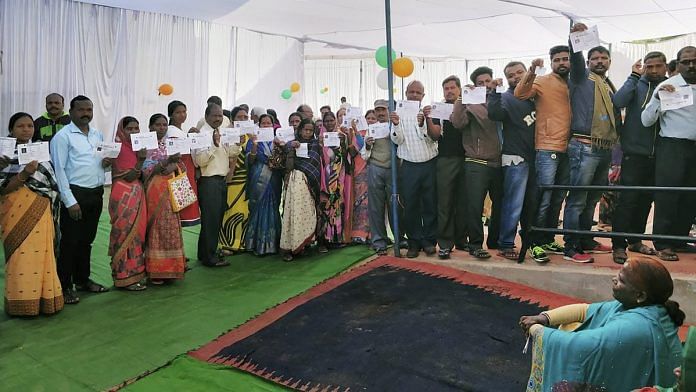
NOTA has got more votes than parties such as BSP, SP & CPI(M) in some state polls, but under current laws, even a 99% NOTA vote can’t defeat a candidate.
New Delhi: The Supreme Court ordered the introduction of the None of the Above (NOTA) option in the voting process in 2013, and since then it has gained more and more popularity.
The situation now is that in some assembly elections, the number of NOTA votes is greater than what parties like the BSP and SP receive, an analysis of the vote share has revealed.
In Madhya Pradesh, for example, the vote share of the Samajwadi Party (SP), 1.3 per cent, was lower than that of NOTA (1.4 per cent).
NOTA (2 per cent) also surpassed the Communist Party of India (0.3 per cent) in Chhattisgarh, while beating the Communist Party of India (Marxist) by 0.1 per cent in Rajasthan, where 1.3 per cent chose against voting for any candidate.
Barring Mizoram, all four states where the recent polls were held cast over 1 per cent of their votes for NOTA. The figure for Telangana was 1.1 per cent.
The Election Commission, however, says the option can never reach its full potential, because there is no legal provision to back it up with action, such as a re-poll.
The number of NOTA voters, though, has fallen since the last election. In 2013, 3.06 per cent of Chhattisgarh’s voters had opted for NOTA (the highest ever for India), with Rajasthan and Madhya Pradesh clocking 1.92 and 1.9, respectively.
The independent figures for Telangana’s last election in 2014 were not available, but 0.64 per cent of united Andhra’s voters had chosen NOTA in the assembly poll that year.
Also read: NOTA outperforms SP, AAP, NCP & others in assembly polls for five states
What happened in the states
In assembly elections between 2013 and 2018, NOTA received an average of 1.04 per cent of the vote share.
In Himachal Pradesh in 2017, NOTA got 0.92 per cent of the votes, comfortably ahead of the BSP’s 0.79 per cent.
In the Goa elections earlier that same year, NOTA received 1.19 per cent of the votes, outpacing the country’s oldest Left party, the CPI, which got just 0.59 per cent.
In Gujarat 2017, NOTA received 1.85 per cent of the votes, which was more than that secured by the CPI (1.50), CPI(M) (1.50) and the BSP (0.90 per cent).
In Karnataka in May 2018, the AIADMK, the leading party of neighbouring Tamil Nadu, got just 0.48 per cent of the vote, half of NOTA’s share (0.86).
Lack of legal support
Former Chief Election Commissioner O.P. Rawat said the lack of a legal framework to back NOTA rendered it inconsequential.
“There is no provision that if a certain number of votes are polled for NOTA, something can happen,” he said. “Therefore, people who feel strongly against the candidates fielded from their constituency vote for NOTA, knowing full well that it will be inconsequential,” he said.
“The Election Commission had to introduce the option of NOTA on the directions of the Supreme Court,” Rawat added. “Beyond that, we do not have any powers to act on the outcome of NOTA votes.
“The Election Commission follows the rule that the candidate who secures the highest number of votes will have to be declared the winner (called first-past-the-post),” he said. “Even if NOTA secures 99 per cent of the votes and a candidate gets 1 per cent, we will have to declare the candidate a winner, because NOTA is no candidate.”
The way out
Rawat said if the states wanted, they could use their plenary powers to make NOTA mean something.
“Maharashtra had recently come up with an order that if NOTA gets the maximum votes, none of the contesting candidates will be declared the winner and there will be a re-poll,” he added. “This is the way in which there can be an outcome, but the Election Commission as such cannot do anything.”
Another former CEC, H.S. Brahma, agreed that NOTA should be given more power.
“If the government has introduced a provision, there should be some outcome,” he said, “There needs to be a periodic review every five years on what should be done for NOTA.”
“In case there are 10 to 15 per cent votes for NOTA, there should be a re-election in the constituency because this means that so many people are not happy with the contesting candidates, indicating that there is something definitely wrong there,” Brahma added.

Non-reserved class Hindus, ignored and willfully discriminated by political parties and already categorised as capable of committing atrocities, who are for all purposes no longer citizens of India, must use the NOTA option.